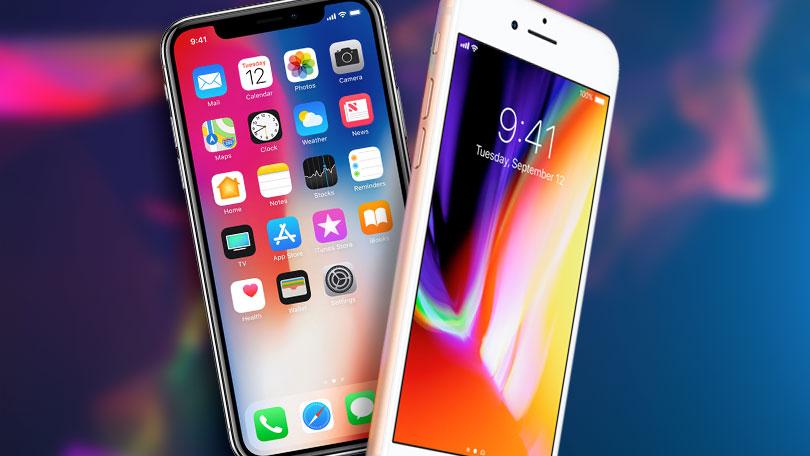iPhone Shopping? A Detailed Guide To The iPhone 8 and iPhone X
November 15, 2017

On November 3, 2017 Apple officially released its latest flagship device known as the iPhone X. Alongside this device, Apple’s very own iPhone 8 plus was released on September 22, 2017.
Right off the bat, they appear very different in their design aspect externally, but internally are very similar to previous models in many of their components. It may become a difficult choice to decide with which one you should get, but in order to help people decide which iPhone they should pick up first. Taking a look at each phone going through their strengths and weaknesses, so a decision can be made.
External Design :
The most obvious difference between the iPhone X and the iPhone 8 Plus has been their external design visually. The iPhone 8 Plus has returned with the same design aspect that has been introduced back in 2014 with the iPhone 6 Plus, whereas the iPhone X has offered a brand new bezel-less design that removes the home button, and its fingerprint scanner on the base of the phone opening it up for more screen real estate. Visually the design differences have been significant, but physically, the two phones have dramatic different form factors.
iPhone X : 143.6 x 70.9 x 7.7 mm (5.65 x 2.79 x 0.30 in), 174g (6.14oz)
iPhone 8 Plus : 158.4 x 78.1 x 7.5 mm (6.28 x 3.07 x 0.32 in), 202g (7.13oz)
Overall, besides the size difference and layout, the two phones retain many similar features. The 8 Plus and X both have the same glass backing to allow wireless charging and added extra grip compared to their previous aluminum backs used by all previous generations leading to the iPhone 5 (2012). The downside to this same glass back panel once again it becomes the hefty price to repair if they are dropped or cracked.
Practically everywhere else these two iPhone’s offer similar features such as they both use the same lighting port as the headphone jack and still feature a dual stereo external speaker. Both phones are up to IP67 water and dust resistance and can handle 30 minutes being submerged into at least one meter of water.
Displays :
The iPhone 8 Plus still has a great display with the 5.5in LCD screen, but in comparison the iPhone X beats out the 8 Plus any day with its new AMOLED display.
iPhone X : 5.8in Super AMOLED Display, 1125 x 2436 screen resolution, 458 PPI, HDR Capability.
iPhone 8 Plus : 5.5in LCD Display, 1080 x 1920 screen resolution, 401 PPI, Not HDR Capable.
The iPhone X overall does not have a physically bigger display than the 8 Plus, but its aspect ratio in comparison to the 8 Plus is increased from the original 16:9 to the extended 18.5:9 display due to the screen real estate with its bezel-less design. The iPhone X’s resolution improvement and the AMOLED screen gives the win definitely to the iPhone X in superior picture quality between the two.
Camera :
The iPhone X and the 8 Plus still feature the same dual camera system and feature identical primary cameras but where the secondary cameras do come with a few minor differences between the two.
iPhone X : Dual camera system, Primary camera 12MP f/1.8 (OIS), Secondary camera 12MP f/2.4 (OIS).
iPhone 8 Plus : Dual camera system, Primary camera 12MP f/1.8 (OIS), Secondary camera 12MP f/2.8 (No OIS)
The iPhone X and the 8 Plus virtually have the same primary (front) camera systems but where the iPhone X pulls ahead is its secondary (back) camera where its 2.4 telephoto camera can be used for a 2x zoom much faster on the iPhone X and features OIS (Optical Image Stabilisation) on both front and back cameras. With the iPhone X’s new Face ID (facial mapping technology) it can now offer its popular Portrait Mode on the front and rear camera whereas the iPhone 8 Plus can only feature it on the rear giving a bonus point to the iPhone X in the selfie department.
Performance :
When comparing the iPhone X and 8 Plus in the performance category there is virtually no difference between the two and both receive identical class leading performance with the use of Apple’s A11 Bionic processor.
iPhone X : A11 Bionic Processor, 6 Core CPU, 6 Core GPU, M11 Motion Coprocessor, 3GB RAM.
iPhone 8 Plus : A11 Bionic Processor, 6 Core CPU, 6 Core GPU, M11 Motion Coprocessor, 3GB Ram.
As in whether or not the iPhone X or 8 Plus takes the victory in performance power, it ends in a draw with the virtually same internals besides the factor of the iPhone X uses the A11 chipset to power its facial recognition ID, but can manage to run just the same overall.
Fingerprint / Face ID :
When it comes down to the difference between the iPhone X and 8 Plus for its Face ID and fingerprint scanner, it becomes a personal preference, this is due to the iPhone X removing its home button with the new display resulting in it use in facial recognition technology in order to unlock one’s phone using the front facing camera. However, the iPhone 8 Plus retains the same fingerprint scanner built into the home button that has been used through many to all recent generations of smart phones.
iPhone X : Facial Recognition ID (Built in to front facing camera)
iPhone 8 Plus : Fingerprint Recognition ID (Built in to home button)
Between the two features they can be used to do virtually the same things as before such as unlocking one’s phone, making purchases and signing in to apps. But many people have been concerned with the possibility of someone who could easily take one’s phone, hold it up to one’s face while sleeping or a photo of you and access all your valuable information, however Apple claims to have implemented many security safeguards in order to prevent this from happening. In the end, to personal preference, with the quick press of a finger or holding a phone up to your face every time to unlock it may be tiresome for others. Overall, the security technology in the two are outstanding and very accurate for this day in age compared to the security in phones many years ago.
Battery & Charging :
The iPhone X and the 8 Plus feature utterly the same capabilities when it comes to their batteries and charging power with the standard lightning charging port and as the use of wireless charging, fast charging and the ability to last up to 24 hours of use on either phone.
iPhone X : 2716 mAh built in rechargeable lithium-ion battery. Lightning charger.
iPhone 8 Plus : 2691 mAh built rechargeable lithium-ion battery. Lightning charger.
Both the iPhone X and 8 Plus feature built in rechargeable lithium-ion batteries that can allow up to 21 hours of wireless talk time, 60 hours of wireless audio playback and can fast charge up to 50% in 30 minutes. The one place the iPhone 8 plus does slightly pull ahead is it has the ability for an extra hour of internet use at 13 hours and a 14 hour use of video playback where the iPhone X is an hour behind both features at 12 hours of internet use and 13 hours of video playback. Whether or not the hour difference may make or break the choice to spend the extra $200 for the iPhone X or go with the cheaper iPhone 8 Plus is a personal preferences, but overall, the battery life and charging capabilities will have to go to the iPhone 8 Plus.
Variants & Pricing :
What it comes down to in the end for most people is for the price worth the features and necessities. The iPhone X and the 8 Plus come with the main original colors of silver and space gray and the extra bonus for the 8 Plus offers the Rose Gold color as well. Both phones also come in two storage sizes such as the standard 64GB, and 256GB. Now the iPhone X will run and at a base price of $1000 for the 64GB and the 8 Plus for about $800 for the same storage then an added $100 for either phone for the additional 256GB upgrade.
iPhone X : $1000 (USD), Colors – Silver, Space Gray, Storage – 64GB, 256GB (+$100).
iPhone 8 Plus : $800 (USD), Colors – Silver, Space Gray, Rose Gold, Storage – 64GB, 256GB (+$100).
In the end the $200 difference between the two phones can mean a lot for some people and may not for others. Coming down to the base of the features, you’re receiving in the iPhone X that the iPhone 8 Plus does not, there is not much to it and are pretty similar internally but not visually. If one’s looking for a the few extra bells and whistles, then the iPhone X is the way to go, but if one’s looking for performance then either phone will do just about the same.
Final Verdict :
The iPhone X’s astounding thousand dollar price tag may be a bit high for the phone in itself. However, the question being answered is if the iPhone X is worth the extra $200 than the $800 iPhone 8 Plus? Most would say no, and most would have to agree just for the amount one is getting for use in relation to the iPhone 8 Plus’s capabilities. The main differences are just the style change from the four year old design since iPhone 6 and the facial ID scanner.
Overall, if looking to upgrade from the iPhone 7 or lower editions then go with the iPhone X because getting the performance, looks and features that would warrant the extra price jump. But if one would have the 8 Plus, their is no need to make the upgrade when getting the same phone just in a different visual appeal.
In the end personal preference is the main way to go, when buying a new phone, get what needs and wants are not what makes one “cool” or “popular” because in the end not worth paying up to $1000 to have the newest phone when it will become outdated a year later.






























